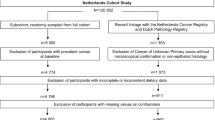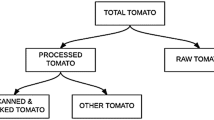Abstract
Objective
To describe the relationship between the intake of fruits, vegetables, and related vitamins and antioxidants, and the risk of prostate cancer in male participants in a large multiethnic cohort study.
Methods
Food and nutrient intakes in 1993–1996 were calculated from a detailed food frequency questionnaire (FFQ) designed to account for the food and nutrient intake of the ethnic groups represented in the study (82,486 African-American, Japanese-American, Native-Hawaiian, Latino and White males included here). Follow-up for incident cancers utilized local SEER registries. Vital status was ascertained using state death files. Data on PSA utilization from a later questionnaire was also examined.
Results
A total of 3,922 incident cancer cases were ascertained during follow-up. Modestly increased risks of prostate cancer were observed in relation to higher intakes of several food items including light green lettuce and dark leafy green vegetables. Notably, no significant protective associations of any foods were seen, including tomato intake; and intakes of two complex foods containing tomato sauce (pizza and Spanish rice) were associated with modest increases in risk. PSA test use was significantly and positively related to intake of some of these same items, implying a degree of disease detection-bias. Analysis of non-localized and high grade disease (1,345 cases) showed no significant protective associations with overall fruits and vegetables intake, related micronutrients, or with intake of selected complex food items.
Conclusions
We found no statistically significant evidence of a protective effect against prostate cancer of higher levels of intake of any of these foods, associated micronutrients or supplements. A possible explanation for the positive associations with risk of several of the foods normally considered to be healthy is detection bias, since “healthy” dietary intake was related to greater use of the PSA test.


Similar content being viewed by others
References
Parkin D, Whelan S, Ferlay J, Raymond L, Young J (eds) (1997) Cancer incidence in five continents, vol VII. IARC Scientific Publications, Lyon
Whittemore AS, Kolonel LN, Wu AH, John EM, Gallagher RP, et al (1995) Prostate cancer in relation to diet, physical activity, and body size in blacks, whites, Asians, in the United States. J Natl Cancer Inst 87:652–661
Kristal AR, Cohen JH, Qu P, Stanford JL (2002) Associations of energy, fat, calcium, and vitamin D with prostate cancer risk. Cancer Epidemiol Biomarkers Prev 11(8):719–725
Hsieh LJ, Carter HB, Landis PK, et al (2003) Association of energy intake with prostate cancer in a long-term aging study: Baltimore Longitudinal Study of Aging (United States). Urology 61(2):297–301
Armstrong B, Doll R (1975) Environmental factors and cancer incidence and mortality in different countries, with special reference to dietary practicies. Int J Cancer 15:617–631
Carroll K, Kohr H (1975) Dietary fat in relation to tumorigenesis. Prog Biochem Pharmacol 10:308–353
Giovannucci E, Rimm EB, Colditz G, Stampfer MJ, Willett WC (1993) A prospective study of dietary fat and risk of prostate cancer. J Natl Cancer Inst 85:1571–1579
Graham S, Haughey B, Byers T, et al (1983) Diet in the epidemiology of carcinoma of the prostate gland. J Natl Cancer Inst 70:687–692
Le Marchand L, Kolonel LN, Wilkens LR, et al (1994) Animal fat consumption and prostate cancer: a prospective study in Hawaii. Epidemiology 5:276–82
Chan JM, Giovannucci E, Andersson SO, Yuen J, Adami HO, Wolk A (1998) Dairy products, calcium, phosphorous, vitamin D, and risk of prostate cancer (Sweden). Cancer Causes Control 9(6):559–566
Chan JM, Giovannucci EL (2001) Dairy products, calcium, and vitamin D and risk of prostate cancer. Epidemiol Rev 23(1):87–92
Chan JM, Stampfer MJ, Ma J, Gann PH, Gaziano JM, Giovannucci EL (2001) Dairy products, calcium, and prostate cancer risk in the Physicians’ Health Study. Am J Clin Nutr 74(4):549–554
Kolonel LN (2001) Fat, meat, and prostate cancer. Epidemiol Rev 23(1):72–81
Mills PK, Beeson WL, Phillips RL, Frasier GE (1989) Cohort study of diet, lifestyle, and prostate cancer in Adventist men. Cancer 64:598–604
Mettlin C, Selenskas S, Natarajan N, Huben R (1989) Beta-carotene and animal fats and their relationship to prostate cancer risk. A case–control study. Prev Med 9:601–606
Schuurman AG, Goldbohm RA, Dorant E, van den Brandt PA (1998) Vegetable and fruit consumption and prostate cancer risk: a cohort study in The Netherlands. Cancer Epidemiol Biomarkers Prev 7(8):673–680
Ohno Y, Yoshida O, Oishi K, Okada K, Yamabe H, Schroeder F (1998) Dietary beta-carotene and cancer of the prostate: a case–control study in Kyoto, Japan. Cancer Res 48:1331–1336
Jain MG, Hislop GT, Howe GR, Ghadirian P (1999) Plant foods, antioxidants, and prostate cancer risk: findings from case–control studies in Canada. Nutr Cancer 34(2):173–184
Giovannucci E, Ascherio A, Rimm E, Stampfer M, Colditz G, Willett W (1995) Intake of carotenoids and retinol in relation to risk of prostate cancer. J Natl Cancer Inst 87(23):1767–1776
Kolonel LN, Hankin JH, Whittemore AS, et al (2000) Vegetables, fruits, legumes and prostate cancer: a multiethnic case–control study. Cancer Epidemiol Biomarkers Prev 9(8):795–804
Hsing AW, Chokkalingam AP, Gao YT, et al (2002) Allium vegetables and risk of prostate cancer: a population-based study. J Natl Cancer Inst 94(21):1648–1651
Giovannucci E, Rimm EB, Liu Y, Stampfer MJ, Willett WC (2002) A prospective study of tomato products, lycopene, and prostate cancer risk. J Natl Cancer Inst 94(5):391–398
Key TJ, Allen N, Appleby P, et al (2004) Fruits and vegetables and prostate cancer: no association among 1104 cases in a prospective study of 130544 men in the European Prospective Investigation into Cancer and Nutrition (EPIC). Int J Cancer 109(1):119–124
Clinton S, Giovannucci E (1998) Diet, nutrition, and prostate cancer. Annu Rev Nutr 18:413–440
Chan JM, Giovannucci EL (2001) Vegetables, fruits, associated micronutrients, and risk of prostate cancer. Epidemiol Rev 23(1):82–86
Etminan M, Takkouche B, Caamano-Isorna F (2004) The role of tomato products and lycopene in the prevention of prostate cancer: a meta-analysis of observational studies. Cancer Epidemiol Biomarkers Prev 13(3):340–345
Le Marchand L, Hankin JH, Kolonel LN, Wilkens LR (1991) Vegetable and fruit consumption in relation to prostate cancer risk in Hawaii: a reevaluation of the role of beta-carotene. Am J Epidemiol 133:215–219
Cook NR, Stampfer MJ, Ma J, et al (1999) Beta-carotene supplementation for patients with low baseline levels and decreased risks of total and prostate carcinoma. Cancer 86(9):1783–1792
Heinonen OP, Albanes D, Virtamo J, et al (1998) Prostate cancer and supplementation with alpha-tocopherol and beta- carotene: incidence and mortality in a controlled trial. J Natl Cancer Inst 90(6):440–446
Kristal AR, Stanford JL, Cohen JH, Wicklund K, Patterson RE (1999) Vitamin and mineral supplement use is associated with reduced risk of prostate cancer. Cancer Epidemiol Biomarkers Prev 8(10):887–892
Chan JM, Stampfer MJ, Ma J, Rimm EB, Willett WC, Giovannucci EL (1999) Supplemental vitamin E intake and prostate cancer risk in a large cohort of men in the United States. Cancer Epidemiol Biomarkers Prev 8(10):893–899
Helzlsouer KJ, Huang HY, Alberg AJ, et al (2000) Association between alpha-tocopherol, gamma-tocopherol, selenium, and subsequent prostate cancer. J Natl Cancer Inst 92(24):2018–2023
Group HPSC (2002) MRC/BHF Heart Protection Study of antioxidant vitamin supplementation in 20,536 high-risk individuals: a randomised placebo-controlled trial. Lancet 360(9326):23–33
Lonn E, Bosch J, Yusuf S, et al (2005) Effects of long-term vitamin E supplementation on cardiovascular events and cancer: a randomized controlled trial. JAMA 293(11):1338–1347
Etzioni R, Berry KM, Legler JM, Shaw P (2002) Prostate-specific antigen testing in black and white men: an analysis of medicare claims from 1991–1998. Urology 59(2):251–255
Merrill RM (2001) Demographics and health-related factors of men receiving prostate-specific antigen screening in Utah. Prev Med 33(6):646–652
Close DR, Kristal AR, Li S, Patterson RE, White E (1998) Associations of demographic and health-related characteristics with prostate cancer screening in Washington State. Cancer Epidemiol Biomarkers Prev 7(7):627–630
Kolonel LN, Henderson BE, Hankin JH, et al (2000) A multiethnic cohort in Hawaii and Los Angeles: baseline characteristics. Am J Epidemiol 151(4):346–357
United States, Department of Agriculture (1992) Nutrient database for standard reference, release 10. Human Nutrition Information Service USDA Bethesda, MD
Stram DO, Hankin JH, Wilkens LR, et al (2000) Calibration of the dietary questionnaire for a multiethnic cohort in Hawaii and Los Angeles. Am J Epidemiol 151(4):358–370
Rosner B, Spiegleman D, Willet W (1990) Correction of logistic regression relative risk estimates and confidence intervals for measurement error: the case of multiple covariates measured with error. Am J of Epidemiol 132:734–745
Monroe KR, Yu MC, Kolonel LN, et al (1995) Evidence of an X-linked or recessive genetic component to prostate cancer risk. Nat Med 1(8):827–829
Hsing AW, Comstock GW, Abbey H, Polk BF (1990) Serologic precursors of cancer. Retinol, carotenoids, and tocopherol and risk of prostate cancer. J Natl Cancer Inst 82(11):941–946
Rohan TE, Howe GR, Burch JD, Jain M (1995) Dietary factors and risk of prostate cancer: a case–control study in Ontario, Canada. Cancer Causes Control 6(2):145–154
Hayes RB, Bogdanovicz JF, Schroeder FH, et al (1988) Serum retinol and prostate cancer. Cancer 62(9):2021–2026
Acknowledgments
This work has been supported by R01 CA 54281, Multiethnic/Minority Cohort Study of Diet and Cancer. Special thanks to Dr. Kris Monroe and Faye Nagamine for study coordination and administration, and to Stuart Wugalter for statistical programming. We are indebted to the members of the Multiethnic Cohort Study for their participation and ongoing commitment.
Author information
Authors and Affiliations
Corresponding author
Additional information
*Supported by Public Health Service (National Cancer Institute) grant R01 CA 54281.
Appendix
Appendix
Rights and permissions
About this article
Cite this article
Stram, D.O., Hankin, J.H., Wilkens, L.R. et al. Prostate cancer incidence and intake of fruits, vegetables and related micronutrients: the multiethnic cohort study* (United States). Cancer Causes Control 17, 1193–1207 (2006). https://doi.org/10.1007/s10552-006-0064-0
Received:
Accepted:
Issue Date:
DOI: https://doi.org/10.1007/s10552-006-0064-0




